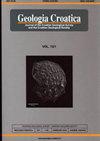编辑:Dinarides-Hellenides的主要和次要资源
IF 1.1
4区 地球科学
Q3 GEOLOGY
引用次数: 0
摘要
初级和次级矿产资源对欧盟经济具有战略重要性。欧盟已经认识到确保未来获得矿产资源、满足欧洲工业需求、保护就业和确保进一步发展的重要性。本期特刊专门介绍东南欧的矿产潜力,更具体地说是亚得里亚海地区(包括阿尔巴尼亚、波斯尼亚和黑塞哥维那、克罗地亚、黑山、北马其顿和塞尔维亚),该地区对应于Dinarides、最西北的Hellenides和Vardar地区,有着悠久的采矿历史。这六篇论文聚焦于初级和次级矿产资源,是参与欧洲创新与技术研究所(EIT)资助的项目“探索东欧和东南欧地区的矿产潜力”的一个大型团队工作的结果。矿产潜力测绘促成了西巴尔干矿产登记册(公开数据),使该地区能够融入泛欧矿产信息网络,并使其更接近共同矿产市场。主要原材料数据指的是可能对进一步勘探/开采感兴趣的活跃、废弃和关闭的矿山,以及潜在的绿地。次要原材料数据包括矿山废料场的信息(包括采矿、加工和冶金废料)。BOROJEVIćŠOŠTARIć等人(2022)评估了亚得里亚海地区矿产部门的主要优势和挑战。他们介绍了矿产勘探和开采的现状,提供了SWOT和差距分析,并制定了促进亚得里亚海地区矿产部门投资的必要行动路线图。RADUSINOVIß等人证明了黑山发现和开发原生和次生矿产资源的潜力。(2022),他们介绍了主要的金属矿产资源(铝土矿、铅和锌),丰富的非金属矿产资源(工业矿产和建筑材料)和次生矿产资源(特别是铝红色泥浆和Pb和Zn操作和废弃的尾矿、火力发电厂的底灰和飞灰、钢铁生产的矿渣以及矿床上盘的泥灰岩和石灰石)和用于骨料生产的废石。SERAFIMOVSKI等人(2022)概述和合成了北马其顿共和国正在开采的几个重要多金属矿床(Buchim铜矿、Sasa铅锌矿、Zletovo和Toranica)以及新的勘探目标(Plavica、Ilovica、Kadiica、Borov Dol)。提交人展示了北马其顿共和国巨大的多金属矿潜力。STEINER等人(2022)对塞尔维亚(Bor,斑岩Cu/Au;Krivelj,斑岩Cu/al;Blagodat,热液Pb-Zn;Lece,超热液Au;Rudnik,热液/skarn Pb-Zn)和北马其顿的活动和废弃矿山的选定尾矿进行了基本表征(Sasa,Pb-Zn;Probištip,PbZn;Bučim,斑岩Cu;Lojane,流纹岩和蛇纹岩接触处的断层束缚脉型低温As、Sb、Cr)。Hellenides Dinarides的初级和次级资源本文章由计算机程序翻译,如有差异,请以英文原文为准。
Editorial: Primary and secondary resources of the Dinarides-Hellenides
Primary and secondary mineral resources are of strategic importance to the EU economy. The EU has recognized the importance of securing access to mineral resources in the future, meeting the needs of European industry, preserving jobs and ensuring further development. This special issue is dedicated to the mineral potential of South-eastern Europe, more specifically the Adria region (including the countries of Albania, Bosnia and Herzegovina, Croatia, Montenegro, North Macedonia and Serbia), which corresponds to the Dinarides, the northwesternmost Hellenides, and the Vardar zone and has a long history of mining. The six papers, which focus on primary and secondary mineral resources, are the result of the work of a large team involved in the European Institute of Innovation and Technology (EIT)funded project rESEErve Mineral potential of the Eastern and South-Eastern Europe region. Mineral potential mapping led to the Western Balkans Mineral Register (publicly available data), which enabled the integration of the region into a pan-European mineral information network and brought it closer to the common mineral market. Primary raw materials data refers to active, abandoned and closed mines that could be of interest for further exploration / exploitation, as well as prospective greenfield sites. The secondary raw material data include information on mine waste sites (including mining, processing and metallurgical wastes). BOROJEVIĆ ŠOŠTARIĆ et al. (2022) assessed the main strengths and challenges of the mineral sector in the Adria region. They present the status of mineral exploration and exploitation, provide a SWOT and Gap analysis, and developed the roadmap for the necessary actions to promote investments in the mineral sector in the Adria region. The potential for discovery and exploitation of primary and secondary mineral resources in Montenegro is demonstrated by RADUSINOVIĆ et al. (2022), who present the main metallic mineral resources (bauxite, lead and zinc), abundant non-metallic mineral resources (industrial minerals and construction materials) and secondary mineral resources (in particular, aluminous red mud and Pb and Zn operational and abandoned mine tailings, bottom and fly ash from thermal power plants, slag from steel production, and marlstone and limestone from hanging walls of coal deposits) and waste rock for aggregate production. SERAFIMOVSKI et al. (2022) present an overview and synthesis of several important polymetallic mineral deposits under exploitation in the Republic of Northern Macedonia (copper mine Buchim, lead-zinc mines Sasa, Zletovo and Toranica) as well as new exploration targets (Plavica, Ilovica, Kadiica, Borov Dol). The authors demonstrate the significant polymetallic ore potential in the Republic of Northern Macedonia. STEINER et al. (2022) have produced a basic characterization of selected tailings of active and abandoned mines in Serbia (Bor, porphyry Cu/Au; Krivelj, porphyry Cu/Au; Blagodat, hydrothermal Pb-Zn; Lece, epithermal Au; Rudnik, hydrothermal/ skarn Pb-Zn) and North Macedonia (Sasa, Pb-Zn; Probištip, PbZn; Bučim, porphyry Cu; Lojane, fault-bound vein-type low-temperature As, Sb, Cr at the contact of rhyolite and serpentinite). Primary and secondary resources of the Dinarides-Hellenides
求助全文
通过发布文献求助,成功后即可免费获取论文全文。
去求助
来源期刊

Geologia Croatica
GEOSCIENCES, MULTIDISCIPLINARY-
CiteScore
2.90
自引率
23.10%
发文量
35
审稿时长
>12 weeks
期刊介绍:
Geologia Croatica welcomes original scientific papers dealing with diverse aspects of geology and geological engineering, the history of the Earth, and the physical changes that the Earth has undergone or it is undergoing. The Journal covers a wide spectrum of geology disciplines (palaeontology, stratigraphy, mineralogy, sedimentology, petrology, geochemistry, structural geology, karstology, hydrogeology and engineering geology) including pedogenesis, petroleum geology and environmental geology.
Papers especially concerning the Pannonian Basin, Dinarides, the Adriatic/Mediterranean region, as well as notes and reviews interesting to a wider audience (e.g. review papers, book reviews, and notes) are welcome.
 求助内容:
求助内容: 应助结果提醒方式:
应助结果提醒方式:


